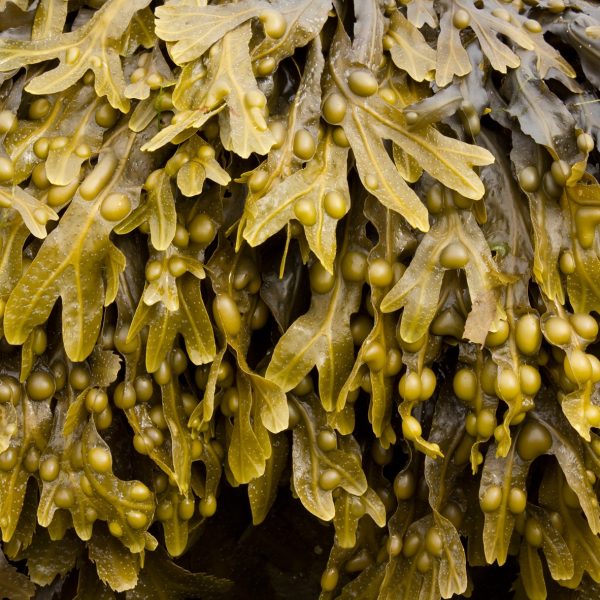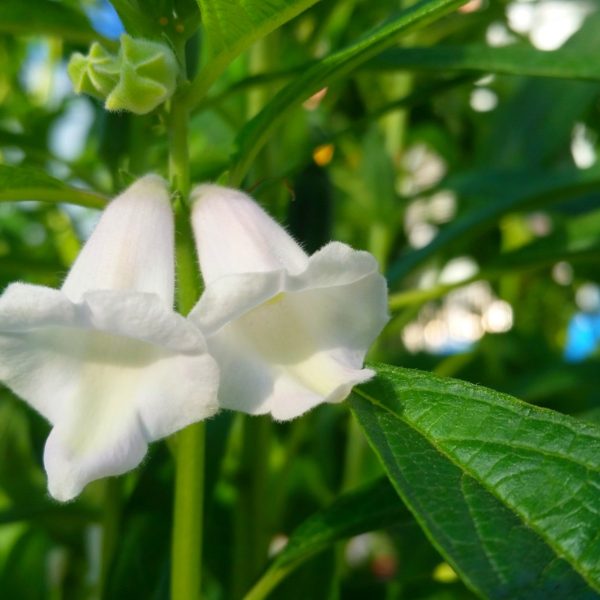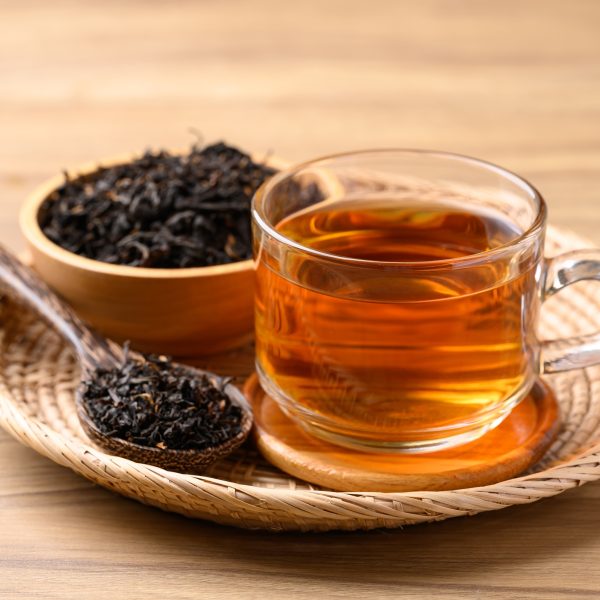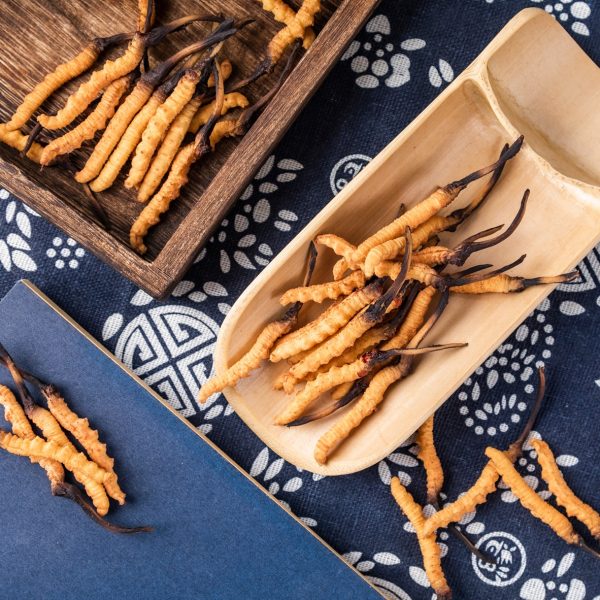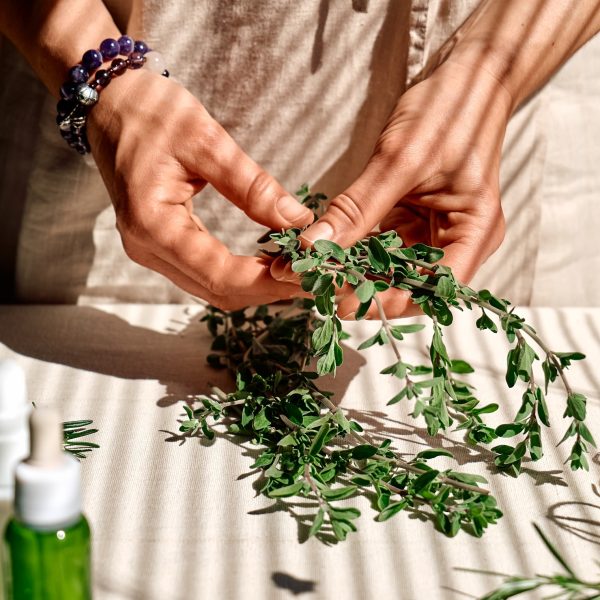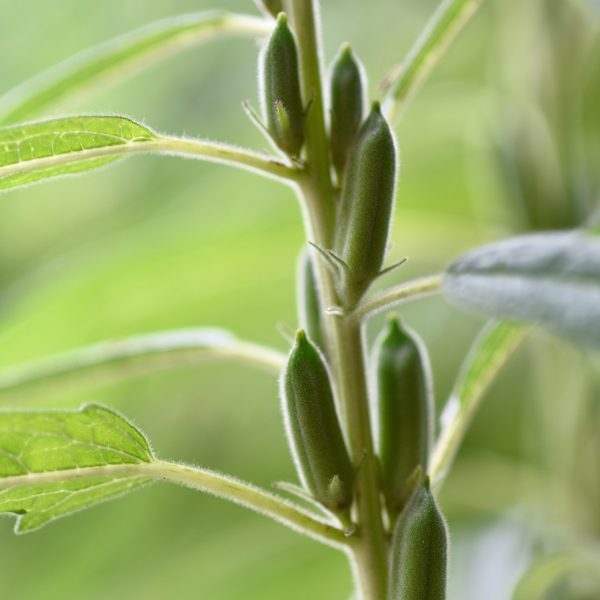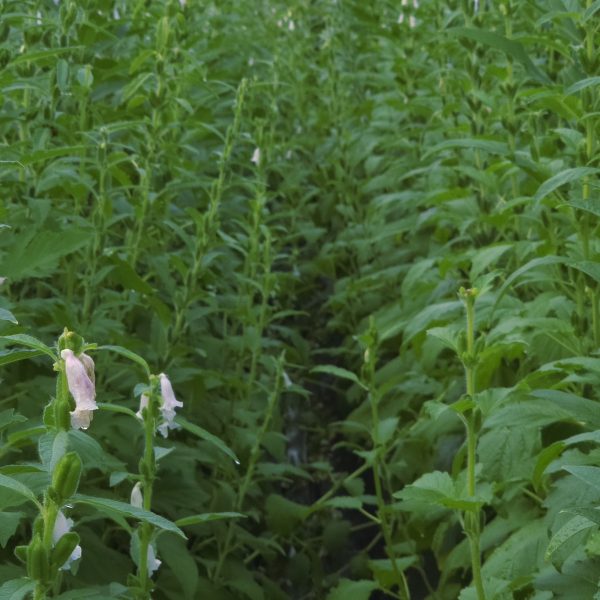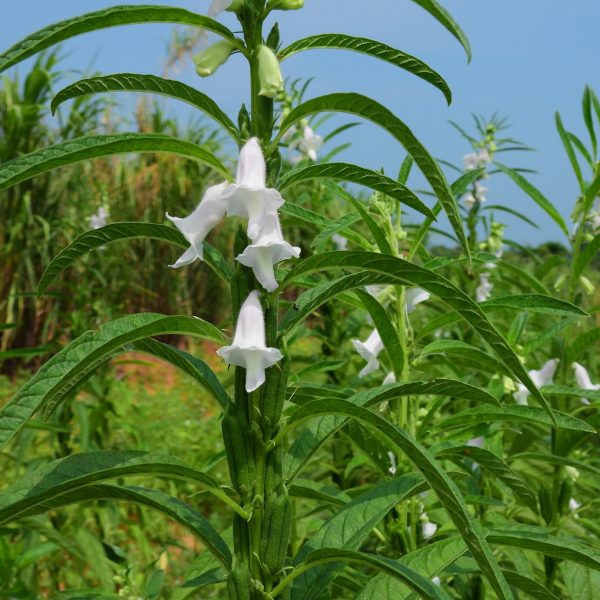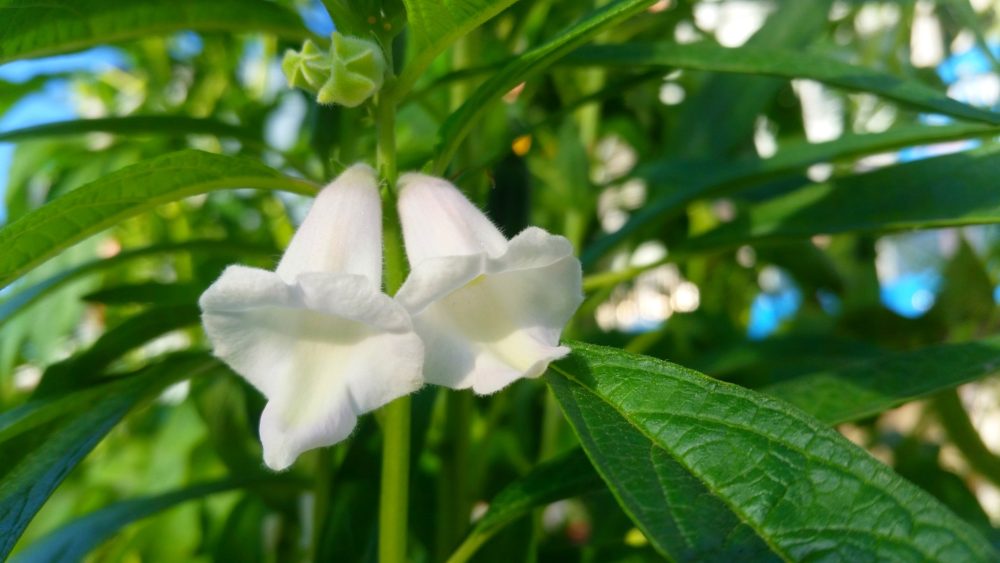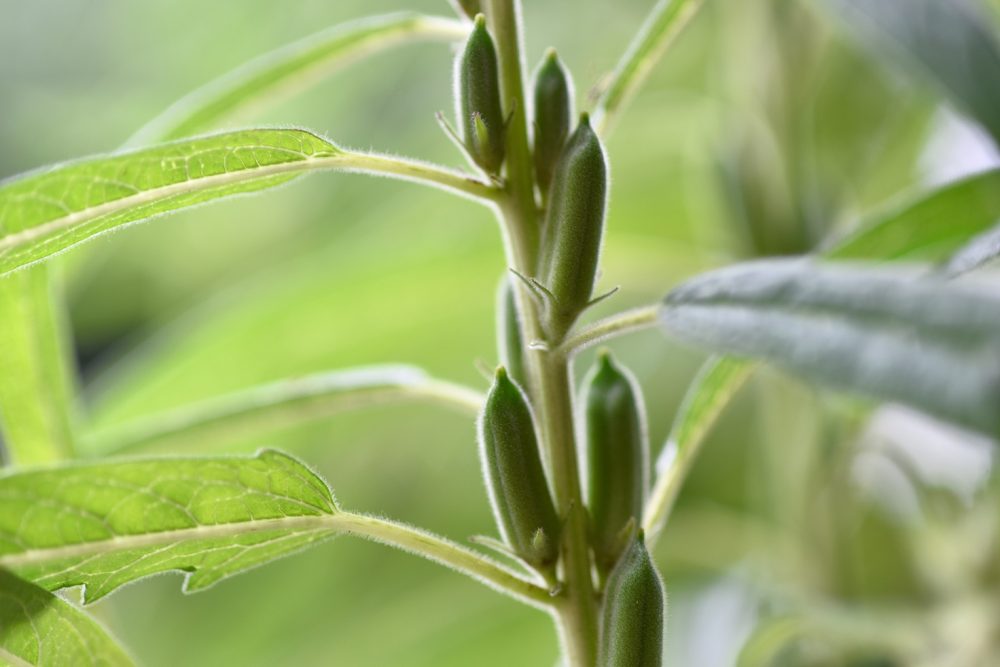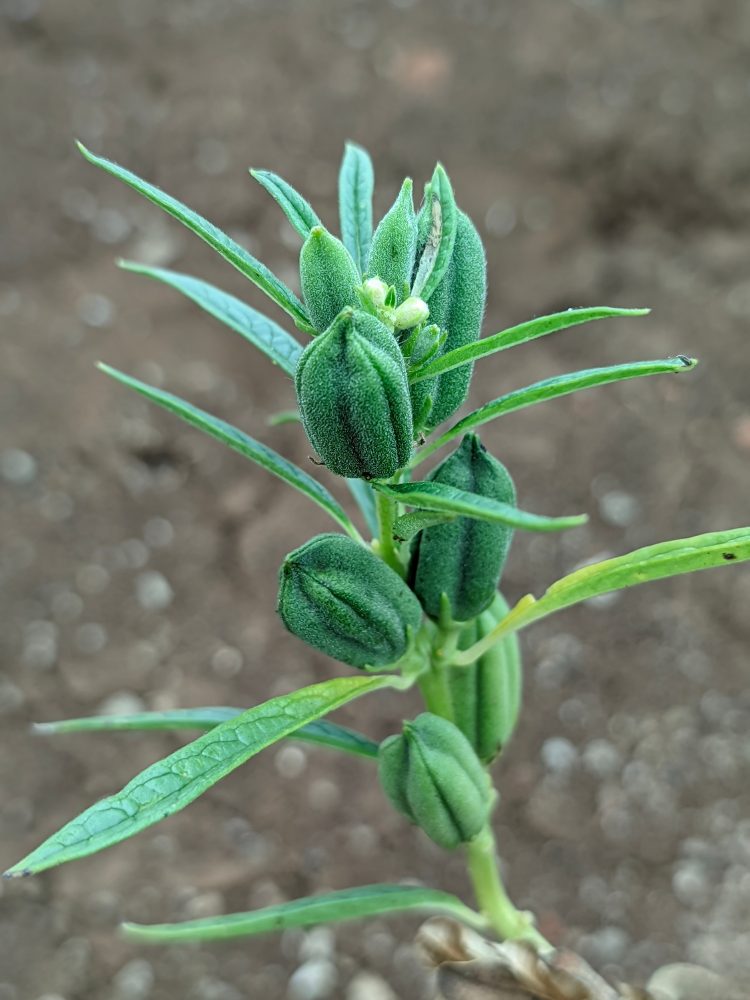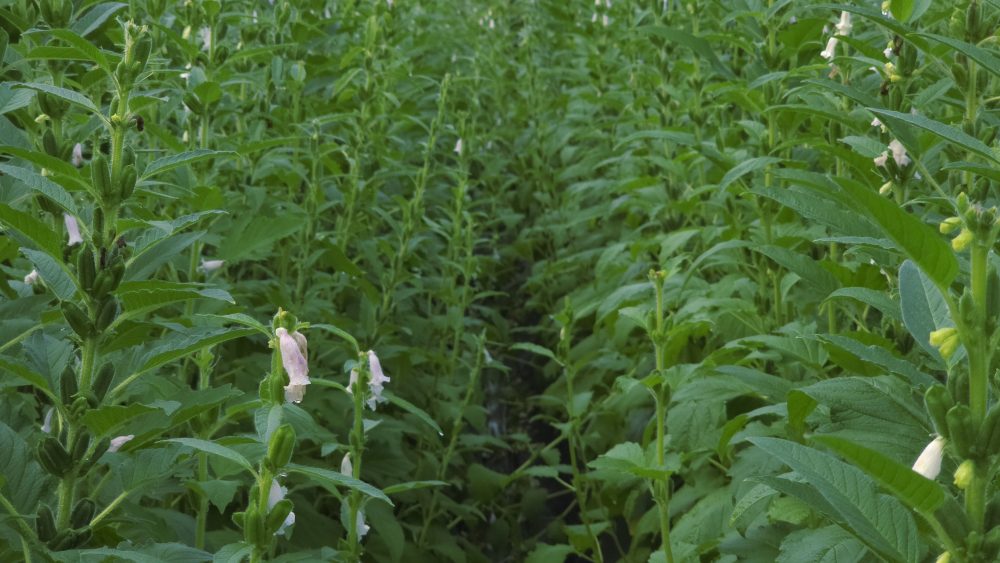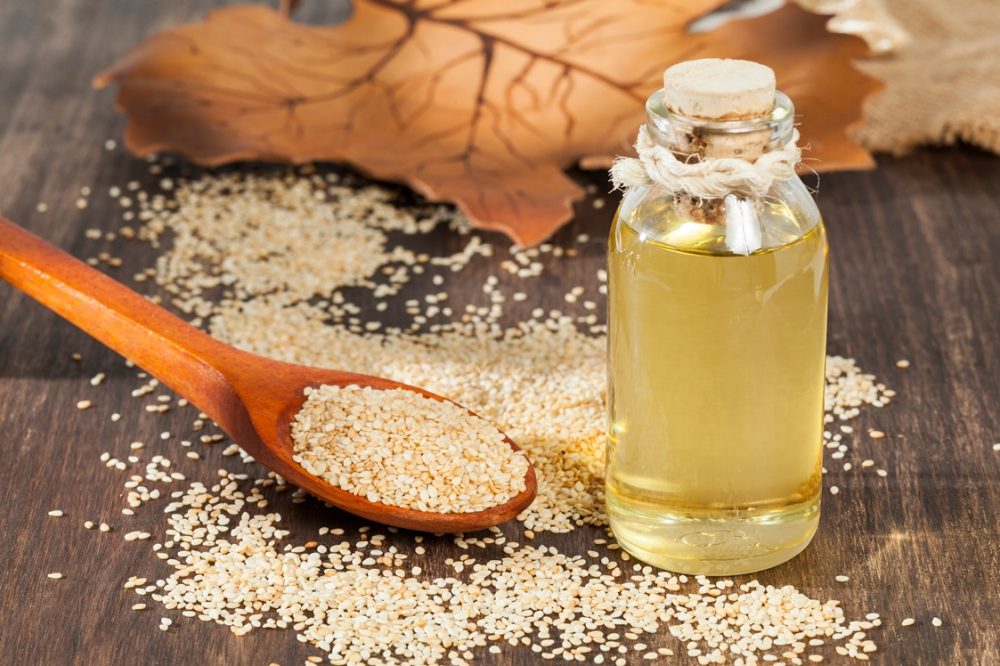-
How does it feel?
-
What can I use it for?

Sesame (Sesamum indicum) Sesame is known as the ‘queen of oils’ in Ayurveda as it has such a wide scope of use. It is used as a base to prepare many medicated oils which are used internally in panchakarma procedures, such as medicated herbal enemas, nasal application and ear drops. It allows fat-soluble medicinal compounds to penetrate the body very effectively, enhancing absorption into the nervous and circulatory systems. Sesame seed and its oil are excellent laxatives. It is also processed with herbs having vulnerary (wound healing) properties to prepare specific vulnerary oils. Indeed, around 90 % of the herbal oils used in Ayurveda are sesame oil. There is an understanding that in any Sanskrit verse of Ayurvedic medicine, if taila (oil) is mentioned but the specific type of oil is not mentioned, then sesame oil should be taken by default (1). It is also used as an ingredient in many herbal medicated jams.
Ayurvedic oil massage is a key part of the Ayurvedic daily routine (dinacharya) as it increases circulation, calms vata dosha, and the nervous system and prevents dry skin. The beauty of an Ayurvedic self-massage is that it will only take around 20 minutes and costs nothing. Sesame oil is also the most widely used oil for external massage (abhyanga), and is safe for babies and children. It is considered one of the most potent oils for balancing vata dosha and nourishing the body’s tissues (dhatus). It helps to strengthen bones, muscles and joints, improves the quality of skin and hair and gives overall strength. It is used for shirodhara (pouring of warm oil on the third eye), which helps to calm the mind, relieve headaches and induce deep relaxation. The combination of daily sesame oil massage with shirodhara with a sesame based herbal oil has been shown to improve stress markets (2). Sesame oil is preferred to coconut oil for oil pulling to support gum health and heal mouth ulcers. It is also preferred to coconut oil for supporting hair health.
These tiny seeds pack a concentrated amount of nutrients, including healthy fats, protein, vitamins and minerals. Sesame oil’s rich content of antioxidants (sesamin, sesamol) and essential fatty acids are thought to provide neuroprotective and anti-inflammatory effects. These compounds may support brain function, reduce oxidative stress and modulate stress responses, complementing traditional Ayurvedic practices like massage, shirodhara and nasal therapies.
-
Into the heart of sesame

Sesame (Sesamum indicum) Sesame seed has been used for centuries in various cultures, with a particularly special place in Ayurvedic medicine. While Ayurvedic texts describe sesame oil primarily in terms of being vata dosha balancing, modern interpretations link to its composition in phytochemical antioxidants and profile in unsaturated fatty acids, meaning sesame is used as a biological source of essential fatty acids. It contains bioactive compounds such as lignans (sesamin, sesamol, sesamolin), tocopherols and phytosterols. The oleic/linoleic fatty acids ratio of sesame makes it important for human health (3). Black seeds contain more calcium than white. As per Bhavaprakasha, “The black sesame seeds are the best. White is of medium quality and the rest of the sesame seeds including red are of inferior quality” (4).
Sesame seed oil is regarded in Ayurveda as a nourishing, warming, and grounding oil that strengthens body tissues, the nervous system and overall vitality through its heavy, unctuous, penetrating and warming potency (ushna virya). These qualities make sesame oil highly moisturising, supporting tissue regeneration and allowing deep and rapid penetration into the body’s channels. Its main taste is sweet, which also supports the building and nourishment of tissues. Regarding dosha effects, it balances vata dosha (especially beneficial for dryness, nervous system imbalances, and restlessness), and kapha dosha, but can mildly aggravate pitta if overused due to its heat and heaviness.
-
Traditional uses

Sesame (Sesamum indicum) For thousands of years, lipid-based Ayurvedic formulations have been made in India, and the craft has survived down the millennia to the present time. Sesame seed and its oil have been in use in both Indian traditional medicine and for culinary uses since antiquity. Vagbhata states that of all the oils, sesame is the best, so one can conclude that sesame oil is the best oil for oral intake or cooking (5). Sesame seed is also described as pathya meaning one of the things to be taken regularly (6). Hence, sesame oil is one of the most widely used oils for cooking in the Indian household.
Both Master Acharyas Charaka and Vagbhata explain the benefits of sesame oil in their classical texts. For example, Charaka writes: “Of all the varieties of oil, sesame oil is best for improving strength and imparting oiliness to the body” (7). When cooked or processed with other drugs, it also becomes more powerful therapeutically. For example, in case of ascites (abnormal build up of fluid) with vata dosha predominance, sesame oil processed with sour herbs is administered as an enema (7). It is stated that there is no medication which excels oil in curing vata-related diseases because of its vyavayi quality (which pervades the body before going through the process of digestion), along with its hot, heavy and unctuous properties (8). This is especially important as aggravated vata dosha is seen as the main ‘troublemaker’ in Ayurveda, being responsible for more diseases than the other two doshas. Continuous use of sesame oil alleviates vata, as its unctuous, hot and heavy qualities effectively balance the dry, cold and light qualities of vata, them being opposite in nature. When there is the interaction between substances having mutually opposite qualities, the stronger dominates over the weaker; therefore, continuous use of oil alleviates vata dosha, both externally and internally (9).
Beyond use on humans, sesame is also used for plants to flower in all seasons as per Vriksha Ayurveda, a component of Agnipurana, an ancient Indian scripture dedicated to the importance of agricultural science. Traditionally, a mixture of sesame oil cakes, vidanga (Embelia ribes), sugar cane juice and cow dung is sprinkled to the root of a plant. This practice enables flowering of the plant in all the seasons (10).
-
Traditional actions
Herbal actions describe therapeutic changes that occur in the body in response to taking a herb. These actions are used to express how a herb physiologically influences cells, tissues, organs or systems. Clinical observations are traditionally what have defined these actions: an increase in urine output, diuretic; improved wound healing, vulnerary; or a reduction in fever, antipyretic. These descriptors too have become a means to group herbs by their effects on the body — herbs with a nervine action have become the nervines, herbs with a bitter action are the bitters. Recognising herbs as members of these groups provides a preliminary familiarity with their mechanisms from which to then develop an understanding of their affinities and nuance and discern their clinical significance.
-
Traditional energetic actions
Herbal energetics are the descriptions Herbalists have given to plants, mushrooms, lichens, foods, and some minerals based on the direct experience of how they taste, feel, and work in the body. All traditional health systems use these principles to explain how the environment we live in and absorb, impacts our health. Find out more about traditional energetic actions in our article “An introduction to herbal energetics“.
Ayurvedic energetics
Western energetics
-
What practitioners say
 Digestive and oral health
Digestive and oral healthSesame oil’s heating nature helps to boost the digestive fire (deepana). It is also absorbent in nature, and is indicated in low digestive fire and malabsorption syndrome. Internal use of sesame oil in controlled Ayurvedic protocols (snehapana) thus enhances digestive fire, promoting better assimilation of nutrients through clearing and clenasing body channels. It is also used to ease bowel movements.
Sesame is used in three ways for good teeth: It is advised for chewing; its paste is used for toothache and it is used for oil pulling. For tingling of the teeth, weak teeth, and any mouth diseases caused by vata imbalance, water mixed with sesame seed paste is held in the mouth for five minutes (gandusha) (11).
Oil pulling is a traditional oral health practice that dates to around 5000 BCE, as detailed in ancient Ayurvedic texts, particularly the Charaka Samhita. In gandusha, the mouth is filled with oil and held for 3–5 minutes without movement, then released. In kavala, a comfortable amount of oil is swished and gargled for a few minutes — sesame oil is preferred with its antibacterial properties. This helps maintain good oral hygiene, ensuring any food debris lodged in the teeth is expelled out when the oil is spit out. The lubricating effect relaxes irritated throat tissues and keeps the mouth moist. Regularly doing gandusha can also help in strengthening the facial muscles.
Nervous
Sesame oil’s heavy (guru), unctuous (snigdha), and warming (ushna) properties perfectly balance vata dosha, which governs movement and the nervous system. It calms the nervous system, reducing anxiety and mental agitation, and supports sleep and relaxation, notably when used in shirodhara, scalp and foot applications. It also enhances focus and cognition due to its medhya property combined with transdermal and nasal (nasya) applications. It deeply penetrates to strengthen nervous system health while moisturizing and supporting tissues.
Reproductive
It supports reproductive health by nourishing shukra dhatu, balancing vata dosha, enhancing ojas, improving circulation, and modulating hormones. Vata dosha governs movement, including neural and reproductive functions. Excess can cause dryness, irregular menstruation, and lowered vitality. Sesame oil’s grounding and warming nature calms vata, improving reproductive stability and building ojas, the subtle essence of vitality and immunity, crucial for fertility.
Hence, it is an aphrodisiac, promoting body strength it specifically contributes to the nourishment of shukra dhatu, essential for sperm and ovum health. Sesame oil applied via massage or shirodhara supports nervous system balance, indirectly optimizing reproductive hormonal function (2). Regular internal or external use strengthens reproductive tissues and enhances fertility. In traditional gynecological therapies, sesame oil is applied vaginally to alleviate dryness, strengthen tissues, and reduce discomfort, supporting overall reproductive health.
Musculoskeletal and skin
Sesame oil is the most widely used oil for the daily practice of traditional warm oil massage (abhyanga). Beyond this preventative approach, external use helps to relieve pain, promote fracture healing, loosen joints, reduce dryness of skin and clear wounds. Its oil processed with other herbs can be used in conditions like hemiplegia and facial palsy. Specifically for fractures, its oil can be used in abhyanga massage, sitz bath or a paste applied to wounds to promote healing as it supports ashti dhatu (bone). As hair, nails and teeth are considered a by product of bone tissue, sesame supports these too.
There are specific mentions of its paste use for haemorrhoids to reduce pain — if there are no secretions. Sesame seeds are taken in a cloth and local fomentation is given to relieve pain, swelling and the size of the mass (12). This relief can be explained by its haemostatic action (due to its sweet and astringent tastes). For bleeding haemorrhoids it can be mixed with ghee to balance its hot potency.
Circulatory and heart health
Sesame seed is recognized for its potential to support cardiovascular health, being rich in essential fatty acids including omega-3 and omega-6, which contribute to lowering cholesterol, supporting arterial flexibility, and reducing the risk of heart disease (13,18). They also contain minerals and vitamins that fortify the heart and circulatory system, while their high oil content lubricates tissues and decreases inflammation — an important factor in cardiovascular health.
Regular consumption of sesame seeds is associated with improved heart function and a decreased incidence of heart attacks. Besides heart benefits, sesame also strengthens bones, muscles, and connective tissues, which can indirectly support an overall healthy cardiovascular system.
Urinary
Sesame oil supports urinary health in Ayurveda by pacifying vata, nourishing tissues, and promoting bladder tone and detoxification, which can improve urinary flow and reduce symptoms like frequent urination. It specifically pacifies apana vata which governs the pelvic region and excretion functions. Sesame oil, through its unctuous and warming action, helps stabilise bladder function, easing complications like frequent urination, urinary retention, or weak stream.
It is also indicated in diabetes to reduce urine production and urinary tract infections. When used topically or in medicated preparations, sesame oil can also carry active constituents transdermally to help reduce urinary tract inflammation and support detoxification, indirectly promoting bladder health.
Respiratory
Sesame oil promotes respiratory health by lubricating nasal passages, clearing mucus and balancing vata dosha, mainly through nasal therapies such as nasya and oil massage. Nasya is one of the central Ayurvedic approaches to respiratory health, where a few drops of plain or herbal sesame oil (e.g., anu taila), are instilled into the nostrils. This practice lubricates and protects nasal passages, preventing dryness and irritation; clears mucus and congestion, aiding easier breathing; and balances prana (life force), calming the nervous system and improving airflow to the head and upper respiratory tract.
Ayurveda also emphasises abhyanga or warm sesame oil massage, which can extend to the chest and back for respiratory support, using oil with added herbs such as eucalyptus (Eucalyptus spp.) to support coughs and breathing disorders.
Hair
“One who applies sesame oil on his head regularly does not suffer from headache, baldness, greying of hair, nor does this hair fall. Strength of his head forehead is specially enhanced; his hair becomes black, long and deep-rooted; his sense organs work properly; the skin of his face becomes brightened; applying sesame oil on the head produces sound sleep and happiness” — Charaka Samhita (14)
Sesame oil is one of the most effective keshya substances — promoting hair growth, reducing hair fall, and relieving grey hairs. One of the key reasons it is preferred to coconut oil is that it is heating in nature versus the cooling potency of coconut. Coldness increases kapha dosha, hence, people who are prone to allergies, cold, cough, asthma, etc. can see a worsening of symptoms after applying coconut oil to the head. Even healthy people, who do not have cold problems, can tend to have running nose, upon applying coconut oil at night. Coconut oil is still advised for people with burning sensations on the head or living in hot countries.
-
Research

Sesame (Sesamum indicum) Nasal application of sesame oil-based anu taila as ‘biological mask’ for respiratory health during COVID-19 (15)
This review evaluated the potential role of sesame oil-based anu taila for respiratory health and the prevention of COVID-19 (15). Ayurveda recommends the use of sesame oil and anu taila as a part of daily routine (dinacharya) for oral gargling and trans nasal application (nasya) for preventing upper respiratory tract infections. Recent studies on COVID-19 have elucidated the activity of certain fatty acids in restricting viral binding.
Based on the evidence gathered from in-silico, pre-clinical, and pharmacological studies as well as references from classical textbooks of Ayurveda, this review infers that the trans nasal application of sesame oil and/or anu taila could provide resilience/protection to the respiratory system. It can act as a biological mask to prevent respiratory infections like COVID-19. Detailed pharmacological studies are needed to give fuller confirmation of this informed inference that anu taila offers a cost-effective intervention for the prevention of COVID-19 like infections of the upper respiratory tract.
Effects of Ayurvedic oil-dripping treatment with sesame oil vs. with warm water on sleep: A randomized single-blinded crossover pilot study (16)
Ayurvedic oil-dripping treatment (shirodhara) is often used for treating sleep problems. However, few properly designed studies have been conducted, and the quantitative effect of shirodhara is unclear. This study sought to quantitatively evaluate the effect of sesame oil shirodhara (SOS) against warm water shirodhara (WWS) on improving sleep quality and quality of life (QOL) among persons reporting sleep problems (16).This randomized, single-blinded, crossover study recruited 20 participants. Each participant received seven 30-minute sessions within two weeks with either liquid. The washout period was at least two months.
The shirodhara procedure was conducted by a robotic oil-drip system. The outcomes were assessed by the Pittsburgh Sleep Quality Index (PSQI) for sleep quality, Epworth Sleepiness Scale (ESS) for daytime sleepiness, World Health Organization Quality of Life 26 (WHO-QOL26) for QOL, and a sleep monitor instrument for objective sleep measures. Of 20 participants, 15 completed the study. SOS improved sleep quality, as measured by PSQI. This pilot study demonstrated that SOS may be a safe potential treatment to improve sleep quality in persons with sleep problems.
Ayurvedic lipid based rasayana: A perspective on the preparation and pharmacological significance of lipids on the bioavailability of phytoconstituents (17)
Recent research on the role of phytonutrients in promoting cardiopulmonary, brain and immune health substantially buttress the philosophy underlying the use of lipids in preparing traditional Ayurvedic formulas, since a large number of these bioactives are lipophilic. Being lipoidic, they are absorbed through the lacteals in the small intestine, and are then transported through the thoracic duct directly to the heart, bypassing the liver. The formulations utilizing ghee (clarified butter) or sesame oil as the carrier lipid, either while frying amla or as anupana (adjuvant), have special significance in modulating bodily immunity, since the immune system is housed in lymphatics, which are lipid rich.
Amla and lipid based Ayurvedic rasayans (rejuvenating formulations) are a popular and highly palatable group of phytonutraceutical preparations. This group of polyherbal adaptogenic formulations is classified separately from other formulations in Ayurvedic therapeutics. Several of these health-promoting rasayans are suitable to be consumed by all age-groups in the recommended season and dose.
Current research on endothelial and immune cell receptor mediated uptake of lipoidic molecules, together with the knowledge of lipid absorption pathways, lends credence to the usefulness of rasayans (rejuvenatives) in targeting the cardio-pulmonary and immune systems (17). An attempt has been made in this paper to elucidate the mechanisms underpinning the complex interplay between lipid delivered hydrophobic phyto-molecules, systemic lymphatics and the immune system.
Physicochemical, potential nutritional, antioxidant and health properties of sesame seed oil: A review (18)
Sesame seed oil (SSO) is of great economic and human nutrition interest worldwide. Due to its composition in phytochemical antioxidants and profile in unsaturated fatty acids, sesame is used as a biological source of essential fatty acids. It contains bioactive compounds such as lignans (sesamin, sesamol, sesamolin), tocopherols and phytosterols. The oleic/linoleic fatty acids ratio of sesame makes it important for human health (18). Sesame seed oil has bioactive compounds that can help prevent certain cardiovascular, metabolised and coronary diseases.
The ω-3 and ω-6 fatty acids in SSO are precursors to eicosanoids that regulate the immune system and inflammatory functions. The essential fatty acids contained in this oil are essential for cell construction and highly recommended during the first trimester of pregnancy. The consumption of the oil allows both a decrease in the LDL-cholesterol complex and an increase in the HDL-cholesterol complex. It regulates blood sugar and may have favourable effects on people with liver cancer and those developing fatty liver disease (18).
In this review, the nutritional value, antioxidant properties, and health benefits of SSO have been compiled to provide collective information of nutritional and medical interest.
The impact of sesame oil on postpartum after-pain in multiparous women: A randomised, triple-blind, placebo-controlled clinical trial (19)
This study aimed to evaluate the impact of sesame oil soft gels on postpartum pain in multiparous women. A total of 86 multiparous women participated in a randomised, triple-blind, placebo-controlled trial. The women received a 1.1 g capsule of sesame oil or placebo after vaginal delivery every six hours for 24 hours. After-pain was assessed using a pain-o-meter one hour after each dose of medication or placebo.
After the intervention, the mean scores of pain intensity in the group that received sesame oil soft gels were significantly lower than those in the placebo group. The study showed that soft gels of sesame oil were more effective in reducing the severity of after-pain than was a placebo. Based on these findings, the use of sesame oil gel capsules is recommended for alleviating postpartum after-pain, as these capsules are easily accessible and it is important to note that no side effects were reported in this study, and all participants complied with the intervention (19).
-
Did you know?
It is not just the oil that is used therapeutically. Sesame seeds paste, for example, is used in Ayurveda for internal administration and for application over wounds. Sesame seeds are widely used in various classical Ayurvedic food recipes, in the form of laddu, or its kitchari can be prepared by mixing it with a little rice, green moong gram/dhal and black gram/dhal (21).
Additional information
-
Botanical description
This is an erect annual plant of the family Pedaliaceae, grown for its seeds, which grow up to three feet in height. The leaves of this plant are broad and lanceolate, narrow at the base of the plant. The flowering time of the plant is from October to December and the fruiting time is December to January. The flowers are tubular with a four-lobed mouth. Its flowers may change in colour, its flowers may be different and of white, purple or yellow in colour, most commonly white coloured variety is common in India. Its fruit is pubescent, rectangular in sectional cutting. Sesame seeds are very small in size, have numerous varieties, ovate in shape, thinner at the eye and the coat covering of the seed is smooth and ribbed.
-
Common names
- Tila
- Til taila
-
Safety
Sesame seeds have been ranked highly as one of the nutritional supplement for a high fat diet required in pregnancy because it contains omega-3, omega-6 and DHA which are the important factors for development of brain, eye and many other organs. It also possesses pharmaceutical and nutraceutical applications which are supportive during pregnancy (22). Internal intake of sesame oil has also been shown to reduce postpartum pain (19).
Traditionally, excess consumption of sesame oil was viewed as causing hiccups (hikka) and respiratory disorders with difficulty in breathing (shwasa) (23).
Individuals allergic to sesame should avoid the oil entirely, as it can trigger severe allergic reactions.
-
Interactions
Sesame oil can interact with certain medications, particularly those for diabetes, high blood pressure, and drugs metabolized by the liver, which may lead to changes in drug effectiveness or side effect incidence (24).
-
Contraindications
Excess of sesame can cause increased heat, leading to increase of pitta dosha and skin diseases. Traditionally, sesame is described as achakshushya (not good for eyes) and not good for skin due to the hot potency of sesame oil, especially with eye and skin problems.
-
Preparations
- Seeds — whole, roasted
- Powder — finely ground
- Paste — ground with honey/jaggery
- Oil (plain)
- Medicated oil — with added herbs
- Decoctions
- Energy balls — e.g. ladoo (sesame + jaggery)
- Sesame-herb formulations — e.g. halwa, ghee, pastes
-
Dosage
- Sesame is used in multiple dosage forms — powder, paste, oil, in the form of sesame recipes.
- The powder of the sesame seeds can be taken in the moderate amount of 3–6 g daily
- The oil of this plant can be taken in the dosage of 10 to 20 ml daily
-
Plant parts used
- Seed
- Whole plant
The whole plant is used in the preparation of special Ayurvedic medicine called tila kshara. which has a sharp quality helpful in urinary obstruction and with urinary calculi.
-
Constituents
Sesame seed is widely recognised for its impressive nutritional profile. It is rich in essential fatty acids, including omega 3 and omega 6, which support heart health and encourage healthy skin. It also contains valuable vitamins and minerals that help fortify and energize the body (18).
- Proteins: Sesame seed contains high quality proteins that assist in muscle building and repair
- Healthy fats: Rich in monounsaturated and polyunsaturated fats, which can support healthy cholesterol levels
- Vitamins: Contains important vitamins like B vitamins and vitamin E that help maintain cellular health and proper metabolic functioning
- Minerals: Contains calcium, magnesium, zinc and iron that contribute to bone strength, immune system functioning and energy production
- Antioxidants: Lignans: Sesamin, sesamolin, and sesamol are predominant
These compounds have antioxidant, anti-inflammatory, and lipid-lowering properties and contribute to the oxidative stability of the oil. Tocopherols act as antioxidants and protect both the oil and human cells from free radical damage. Phytosterols help reduce cholesterol absorption and support cardiovascular health.
While sesame seeds contain minerals, the oil itself does not provide substantial amounts. Therefore, while sesame seeds can contribute to mineral intake, sesame oil itself is not a reliable source of minerals.
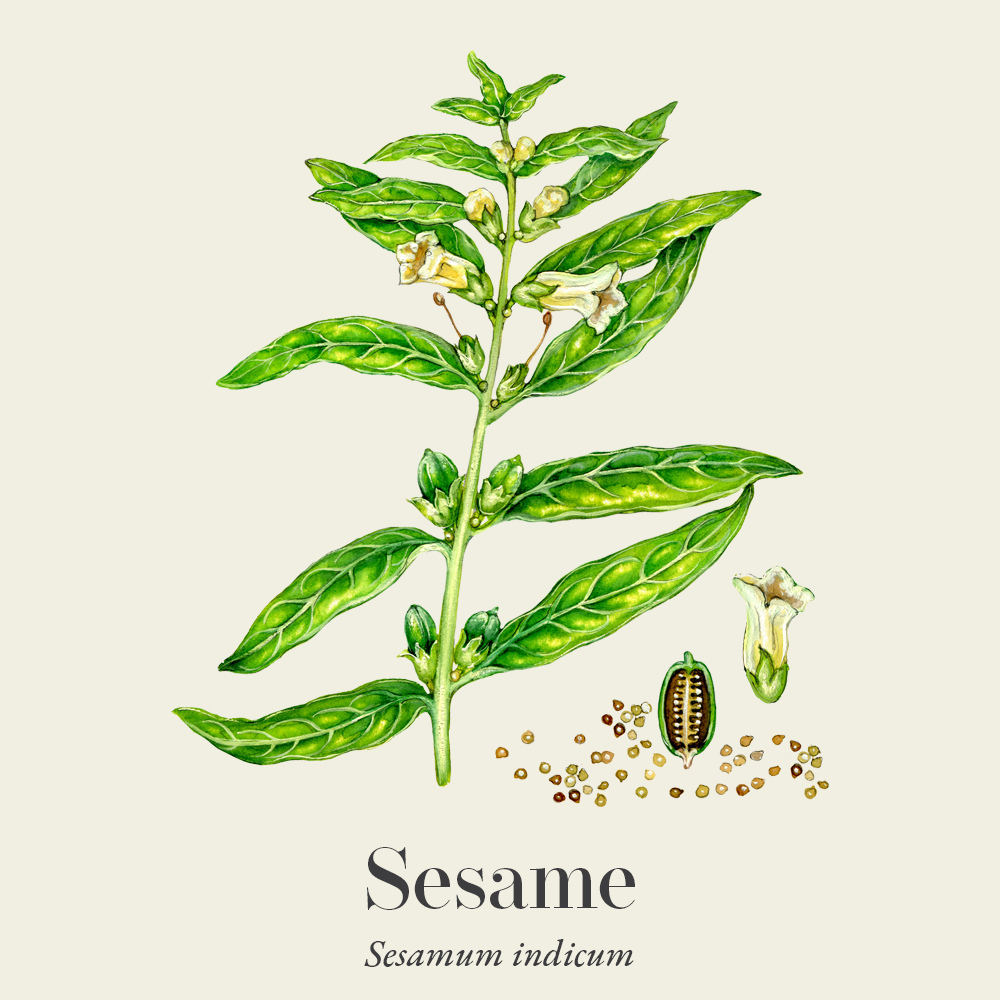
-
Habitat
Sesame is a flowering plant mostly found in the tropical regions of India and Africa.
-
Sustainability

Not currently on risk lists but complete data may be missing on the status of the species. Read more in our sustainability guide. The commercially available sesame (Sesamum indica) is a cultivated variety; wild Sesamum species differ in composition and qualities and is generally not traded. The largest exporters of Sesamum indica are Sudan, India, Nigeria, Ethiopia and Myanmar (25).
Habitat loss and over-harvesting from the wild are two of the biggest threats faced by medicinal plant species. There are an increasing number of well-known herbal medicines at risk of extinction. We must, therefore, ensure that we source our medicines with sustainability in mind.
The herb supplement industry is growing at a rapid rate and until recent years a vast majority of medicinal plant produce in global trade was of unknown origin. There are some very real and urgent issues surrounding sustainability in the herb industry. These include environmental factors that affect the medicinal viability of herbs, the safety of the habitats that they are taken from, as well as the welfare of workers in the trade.
The botanical supply chain efforts for improved visibility (transparency and traceability) into verifiably sustainable production sites around the world is now certificated through the emergence of credible international voluntary sustainability standards (VSS).
Read our article on Herbal quality & safety: What to know before you buy and Sustainable sourcing of herbs to learn more about what to look for and questions to ask suppliers about sustainability.
-
Quality control
Herbal medicines are often very safe to take; however, their safety and efficacy can be jeopardised by quality issues. So, it is important to buy herbal medicines from a reputable supplier, from sources known to test their herbs to ensure there is no contamination, adulteration or substitution with incorrect plant matter, as well as ensuring that recognised marker compounds are at appropriate levels in the herbs.
Some important quality assurances to look for are certified organic labelling, the correct scientific/botanical name, and the availability of information from the supplier about ingredient origins. A supplier should be able to tell you where the herbs have come from, what contaminants are not in the herb, and what the primary compounds are.
-
How to grow
Grow sesame seeds successfully by choosing the right variety, providing warm, sunny conditions, proper soil, careful watering, and timely harvesting.
- Variety selection: Choose white-seeded varieties for cooler climates. Popular options include ‘Ivory’ or ‘Sesaco 43’.
- Preparing soil: Use well-draining sandy or loamy soil with full sun exposure. Enrich with compost or well-rotted manure and avoid waterlogged areas.
- Indoors: Start sowings 4–6 weeks before the last frost, plant ¼ inch deep, keep soil warm and moist.
- Outdoors: Sow after the last frost when soil is above 21°C, spacing seeds 6–12 inches apart.
- Water deeply but infrequently and fertilise lightly before flowering. Avoid overwatering to prevent root rot.
- Watch for aphids, whiteflies, and fungal diseases. Use neem oil, insecticidal soap, and ensure good airflow.
- Ready in 90–120 days when pods turn brown and start to split. Cut plants, hang upside down to dry, and store seeds in airtight containers.
By following these steps, you can grow healthy, nutrient-rich sesame seeds at home even in the UK.
-
Recipe

Sesame (Sesamum indicum) Traditional sesame paste for amenorrhea
Consuming a paste made from soaked black sesame seeds and jaggery is a traditional Ayurvedic home remedy to support the uterus and support hormonal balance in women experiencing delayed periods. While scientific evidence is limited, Ayurvedic Insight indicates that this mixture may help in some cases of amenorrhea or delayed periods due to its nutritional and phytoestrogen content.
Ingredients
- Black sesame seeds
- Jaggery
How to make a traditional sesame paste
- Soak a tablespoon of sesame seeds in water overnight.
- The next morning, drain the seeds and grind to a smooth paste then mix with half a tablespoon of jaggery.
- Eat first thing on an empty stomach.
- The process is repeated for up to seven days.
-
References
- Śārṅgadhara Saṃhitā (Sharngadhara Samhita). Translated by Sharma PV. Varanasi: Chaukhambha Orientalia; 2018.
- Sharma A, Sugandh M, Bhardwaj A, Gupta A. Role of Shirodhara and Abhyanga on serum cortisol in anxiety – a case report. J Ayurveda Integr Med. 2025;16(1):100948.
- Shubhashree MN, Usha C, Annexe NAP, Jayanagar B, Pillar NA. Dietetic and therapeutic effect of sesame in Ayurveda: a critical review. J Pharm Sci Innov. 2023. Available from: https://jpsionline.com/admin/php/uploads/953_pdf.pdf
- Bhāvaprakāśa Nighaṇṭu (Bhavaprakasha Nighantu). Commentary by Chunekar KC, edited by Pandey GS. 10th ed. Varanasi: Chaukhambha Bharati Academy; 2015. Amradiphala Varga.
- Aṣṭāṅga Hṛdaya of Vāgbhaṭa (Ashtanga Hridaya). Annapāna (Food and Drinks), Chapter 5. In: Srikantha Murthy KR, ed. Varanasi: Chaukhambha Krishnadas Academy; 2014.
- Suśruta Saṃhitā (Sushruta Samhita). Sūtrasthāna 46/39. In: Bhishagratna KL, trans. Varanasi: Chaukhambha Sanskrit Series; 2017.
- Caraka Saṃhitā (Charaka Samhita). Sūtrasthāna 13/12. In: Sharma PV, trans. Varanasi: Chaukhambha Orientalia; 2014.
- Caraka Saṃhitā (Charaka Samhita). Cikitsāsthāna 28. In: Sharma PV, trans. Varanasi: Chaukhambha Orientalia; 2014.
- Caraka Saṃhitā (Charaka Samhita). Sthāna 1/14. In: Sharma PV, trans. Varanasi: Chaukhambha Orientalia; 2014.
- Sūrapāla. Vṛkṣāyurveda (Vrikshayurveda): The Science of Plant Life. Translated by Sadhale N. New Delhi: Asian Agri-History Foundation; 1996.
- Aṣṭāṅga Hṛdaya of Vāgbhaṭa (Ashtanga Hridaya). Sūtrasthāna 22. In: Srikantha Murthy KR, ed. Varanasi: Chaukhambha Krishnadas Academy; 2014.
- Caraka Saṃhitā (Charaka Samhita). Cikitsāsthāna 14. In: Sharma PV, trans. Varanasi: Chaukhambha Orientalia; 2014.
- Chang CC, Cheng HC, Chou WC, Huang YT, Hsieh PL, Chu PM, Lee SD. Sesamin suppresses angiotensin II–enhanced oxidative stress and hypertrophic markers in H9c2 cells. Environ Toxicol. 2023;38(9):2165-2172.
- Caraka Saṃhitā (Charaka Samhita). Sūtrasthāna 5/81–83. In: Sharma PV, trans. Varanasi: Chaukhambha Orientalia; 2014.
- Vijay, B., Diwan, B., Devkumar, P., Shankar, P., Vishnuprasad, C.N., Singh, G., Kataria, D. and Shankar, D., 2023. Nasal application of sesame oil-based Anu taila as ‘biological mask’ for respiratory health during COVID-19. Journal of Ayurveda and Integrative Medicine, 14(5), p.100773. https://doi.org/10.1016/j.jaim.2023.100773
- Tokinobu, A., Yorifuji, T., Tsuda, T. and Doi, H., 2016. Effects of ayurvedic oil-dripping treatment with sesame oil vs. with warm water on sleep: a randomized single-blinded crossover pilot study. The Journal of Alternative and Complementary Medicine, 22(1), pp.52-58. https://doi.org/10.1089/acm.2015.0018
- Bali, S., Prasad, S. and Saini, V., 2022. Ayurvedic lipid based rasayans-A perspective on the preparation and pharmacological significance of lipids on the bioavailability of phytoconstituents. Journal of Ayurveda and Integrative Medicine, 13(2), p.100526.https://doi.org/10.1016/j.jaim.2021.09.004
- Oboulbiga, E.B., Douamba, Z., Compaoré-Sérémé, D., Semporé, J.N., Dabo, R., Semde, Z., Tapsoba, F.W.B., Hama-Ba, F., Songré-Ouattara, L.T., Parkouda, C. and Dicko, M.H., 2023. Physicochemical, potential nutritional, antioxidant and health properties of sesame seed oil. https://doi.org/10.3389/fnut.2023.1127926
- Bardar, M.M., Karimi, F.Z., Mazloum, S.R. and Salari, R., 2024. The impact of sesame oil on postpartum after-pain in multiparous women: a randomised, triple-blind, placebo-controlled clinical trial. Journal of Herbal Medicine, 45, p.100885. https://doi.org/10.1016/j.hermed.2024.100885
- Sharma, A., Sugandh, M., Bhardwaj, A. and Gupta, A., 2025. Role of Shirodhara and Abhyanga on serum cortisol in Anxiety–A case report. Journal of Ayurveda and Integrative Medicine, 16(1), p.100948. https://doi.org/10.1016/j.jaim.2024.100948
- Vriksha Ayurveda written by Surapala (1000. A.D)
- Sharma, R., Jain, N., Rani, D. and Kantwa, S.M., 2015. Sesamum indicum before and during pregnancy: a review. International Journal of Research and Development in Pharmacy & Life Sciences, 4(5), pp.1750-1759.
- Caraka Saṃhitā (Charaka Samhita). Cikitsāsthāna 17. In: Sharma PV, trans. Varanasi: Chaukhambha Orientalia; 2014.
- Sesame: Health Benefits, Side Effects, Uses, Dose & Precautions. RxList. Published online. Accessed [insert access date]. https://www.rxlist.com/supplements/sesame.htm
- World Integrated Trade Solution (WITS). Sesamum seeds: Exports by country in 2018. The World Bank. Available from: https://wits.worldbank.org/trade/comtrade/en/country/ALL/year/2018/tradeflow/Exports/partner/WLD/product/120740. Accessed October 17, 2025.

